Spree
The Spree (German: [ˈʃpʁeː] (![]()
| Spree/Sprjewja/Spréva | |
|---|---|
 The Spree in Berlin, Reichstag building to the left | |
| Location | |
| Countries | |
| Physical characteristics | |
| Source | |
| • location | Upper Lusatia |
| Mouth | |
• location | Havel |
• coordinates | 52°32′10″N 13°12′31″E |
| Length | about 400 km (250 mi) |
| Basin size | 10,105 km2 (3,902 sq mi) |
| Discharge | |
| • average | 36 m3/s (1,300 cu ft/s) |
| Basin features | |
| Progression | Havel→ Elbe→ North Sea |
The reach of the river between the Dämeritzsee and Müggelsee to the east of Berlin is known as the Müggelspree (![]()
Course
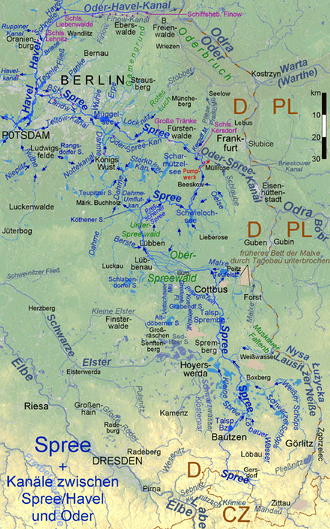
The source of the Spree is a small pond in the Lusatian Highlands near the Czech border. The Spree runs on the border for a short distance at two points (near Ebersbach and Oppach) before leaving the hills and passing through Bautzen/Budyšin in Upper Lusatia. Just to the north of Bautzen the river flows through the Bautzen Reservoir. Further north the river passes through the city of Spremberg before reaching the city of Cottbus. To the north of Cottbus the river enters the Spreewald, a large wetlands area in Lower Lusatia.
In the Spreewald the river passes through the towns of Lübbenau, Lübben and Leibsch. Just below Leibsch, the Dahme Flood Relief Canal diverts water from the Spree to run into the River Dahme at Märkisch Buchholz. The Spree continues north from Leibsch before flowing into the Neuendorfer See at the northern edge of the Spreewald. From the Neundorfer See it then flows in an easterly direction to the Schwielochsee, and then in a northerly and westerly direction to the town of Fürstenwalde. From Fürstenwalde the river continues to flow westwards, through the Dämeritzsee and Müggelsee, to Köpenick in the southeastern part of Berlin, where it is joined by its tributary, the River Dahme.[1]
The final reach of the Spree is where it is best known. It flows through the city centre of Berlin to join the River Havel in Spandau, one of Berlin's western boroughs, which itself ultimately merges with the Elbe to enter the sea in Cuxhaven, after flowing through Hamburg. On its route through Berlin, the river passes Berlin Cathedral (Berliner Dom), the Reichstag and the Schloss Charlottenburg. The renowned Museum Island (Museumsinsel), with its collection of five major museums, is an island in the Spree.[1]
In 2004 the Badeschiff floating swimming pool opened on the Spree in Berlin.[2]
Navigation
Small craft, such as punts, are widely used in wetlands of the Spreewald. Larger craft can reach as far upstream as Leibsch, although the upper reaches are relatively shallow and are generally only used by leisure craft. Some intermediate reaches are unnavigable and by-passed by canals.[1]
For a stretch of about 20 kilometres (12 mi) east of and flowing through Fürstenwalde, the river forms part of the Oder-Spree Canal. On this reach, and on the reach west of the confluence with the River Dahme at Köpenick, the river forms part of secondary commercial link between Berlin and the River Oder and hence Poland.[1] The canal diverges from the Spree just east of Fürstenwalde and later joins the River Dahme at the (lake) Seddinsee.
In Berlin, the Spree forms part of a dense network of navigable waterways, many of which are artificial, and which provide a wide choice of routes. Several important commercial harbours can be found on this network, and tugs and barges move sand, grain, bricks, and beer. Tour boats tour the central section of the Spree and its adjoining waterways on a frequent basis.[1][3]
Berlin Wall
Many people died in the Spree during the Cold War while trying to cross the Berlin Wall, including children who drowned when rescuers were not allowed to enter the river to save them.
Images
.jpg) Spree in Bautzen
Spree in Bautzen- Spree north of Bautzen
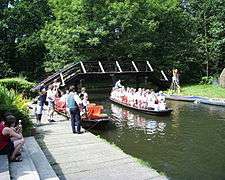 Spree in the Spreewald
Spree in the Spreewald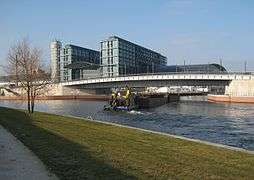 Spree with Berlin Hauptbahnhof & the entrance of a canal
Spree with Berlin Hauptbahnhof & the entrance of a canal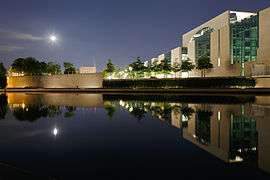 The Federal Chancellery (Berlin) on the Spree
The Federal Chancellery (Berlin) on the Spree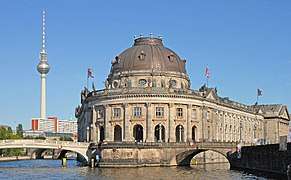 Bode Museum at the tip of Museum Island in the Spree
Bode Museum at the tip of Museum Island in the Spree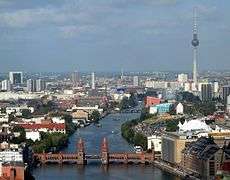 Spree in central Berlin, with Oberbaum Bridge
Spree in central Berlin, with Oberbaum Bridge.jpg) Spree Shore in Berlin Friedrichshain
Spree Shore in Berlin Friedrichshain
References
- Sheffield, Barry (1995). Inland Waterways of Germany. St Ives: Imray Laurie Norie & Wilson. pp. 113–122. ISBN 0-85288-283-1.
- James, Kyle. "A Pool with a View". Deutsche Welle. Retrieved 2010-05-15.
- Gawthrop, John; Williams, Christian (2008). The Rough Guide to Berlin. London - New York - Delhi: Rough Guides. pp. 28–29. ISBN 978-1-85828-382-1.
External links
| Wikimedia Commons has media related to Spree. |
- Panorama Spree - Panoramic view of the river in Berlin
- . Encyclopædia Britannica (11th ed.). 1911.